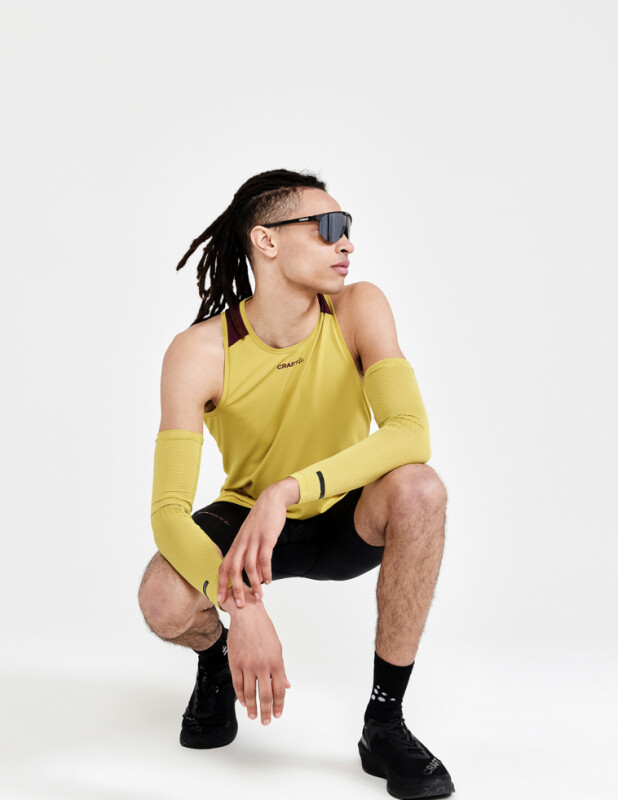Once upon a time, running footwear and apparel focused almost exclusively on utility. If product boasted a little design pizzazz, great, but the importance of performance characteristics far outpaced running gear’s aesthetic appeal. Many run shops, in fact, implored customers to resist purchasing their running shoes based on color.
Those days, of course, evaporated long ago. Fashion and design now hold an important place in the run specialty world, fueled as much by consumer interest as manufacturers’ surging desire to release product that both reflects existing fashion sensibilities and stands out on Instagram — or at least on the shoe wall.
Inspired by the runway, street fashion, luxury brands, travel, textile innovations and even seemingly distant industries such as automotive, many run specialty brands are interpreting fashion for the performance run market through colors, graphics, proportions and layering. At the same time, consumers are seemingly handing brands more creative license than ever before.
“The running demographic has expanded and the lines between fashion and performance continue blurring,” says Noelle Webster, a member of the footwear design team at Brooks who helps craft the looks of the brand’s in-line footwear models as well as its limited-edition SMU releases.
“People see fashion as an opportunity to show their personality and the wide interests they have, which has freed up running products to have more personality.”
Much as some run shops might wish to evade this swelling reality and the inevitable purchasing and customer service conundrums it sometimes brings, an understanding of fashion trends can serve a run shop well.
With the help of product leaders representing five different brands, Running Insight identifies six running footwear and apparel fashion trends expected to accelerate throughout 2022 and into 2023.
1. Trail lands on the roads
A surge in trail running and outdoor exploration amid the pandemic will manifest itself in running fashion for the masses. “Trail inspiration and aspiration in the big city,” Under Armour director of run and basketball apparel Gaby Rodriguez calls it. Muted, earthy tones from greens and blues to even oranges and reds are the obvious development, but the trail-inspired gear transcends color. Expect to see the more durable, gritty fabrics common in trail apparel – think ripstop or water-repellent materials – weave into traditional running apparel as well.
And while these trail-inspired items might incorporate bright colors such as neons, the vibrant touches will often exist as callouts – using color to highlight a zipper or pocket, for instance – to signify sport performance and/or denote the purpose of a garment to the end user, Rodriguez says.
2. Less is more
Simplicity, albeit sophisticated and high quality, will become more and more apparent in performance run fashion, various insiders agree.
Saucony VP–global product Brian Moore predicts a focus on elevated, premium performance product featuring a more understated aesthetic and cleaner finishing as well as fewer parts and pieces.
“You don’t have to go all Power Rangers with it,” Moore says.
And rather than the form-fitting and body-hugging apparel of recent years, Thommy Bäcklin, product manager of Run and XC at Craft, anticipates rising interest in fluid, airy fabrics. This will include performance-oriented apparel using fine, ultra-thin threads, micro holes, engineered ventilation and styling that allows air space between the body and garment to mimic the feeling of running naked.
3. Y2K fashion makes a return
Given that fashion trends typically circle back every 25 years or so, elements of late ’90s and early 2000s styles are already weaving into mainstream fashion and it will almost certainly lead to reinterpretation for performance running apparel. Think pink, metallics, bedazzling and, especially, some looser fits like wider bottoms.
“People want to get away from anything that feels suffocating or constraining,” says Meliha Avdic, senior color and concept designer at Brooks.
4. Color blocking
Fully monochromatic shoes and big blockings of color on footwear are not a new trend in the performance run category, but it is a footwear trend many see accelerating in the coming seasons. In particular, there is likely to be added emphasis on uplifting, vibrant colors in the post-pandemic world, represented most notably in “faster” footwear product like the super shoes.
“People are wearing these in races and on special occasions and want to wear shoes that make a statement,” Saucony’s Moore says.
5. More print and pattern play
Run retailers need to get ready for even more creative, perhaps even outlandish and quirky, footwear design.
Brooks’ Webster foresees heightened interest in bolder print and pattern play on footwear for both genders, which includes tactile moments with new technology and weaving print and pattern play onto the midsole.
“The creative canvas doesn’t end at the upper,” Webster reminds, noting that consumer sentiment from Brooks’ social media channels shows a hearty appetite for eye-catching and distinctive footwear designs.
6. Tying in the environment
Inspired by colors and patterns found along the Pacific coastline, the rabbit design team expects to use saturated earth tones such as forest greens and marine blues mixed with rich sunset colors. Embracing these grounded colors, rabbit co-founder Monica DeVreese says, feels optimistic and restorative.
Beyond colors, Under Armour’s Rodriguez expects to see more organic prints inspired by nature.
“That doesn’t necessarily mean a cheetah or tiger print. It could be the visual you might see on a topographic map,” Rodriguez says.
And, of course, a positive environmental story helps. Gear using recycled materials or constructed with reducing waste in mind adds another layer of connection to the product beyond its function and fashion elements.
“We love that and our consumers love that, too,” Brooks’ Webster says.







